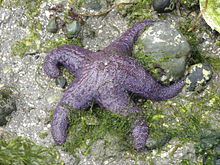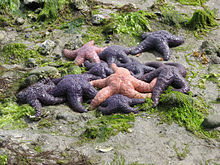- Ochre Sea Star
-
Ochre Sea Star 
Ganges Harbour, British Columbia Scientific classification Kingdom: Animalia Phylum: Echinodermata Class: Asteroidea Order: Forcipulatida Family: Asteriidae Genus: Pisaster Species: P. ochraceus Binomial name Pisaster ochraceus
Brandt, 1835Pisaster ochraceus, generally known as the Purple Sea Star, Ochre Sea Star or Ochre Starfish, is a common starfish found among the waters of the Pacific Ocean.
Contents
Description
This sea star has five stout rays that range in length from 10 to 25 centimeters (4 to 10 in). The rays are arranged around an ill-defined central disk. While most individuals are purple, they can be orange, orange-ochre, yellow, reddish, or brown. The aboral surface contains many small spines (ossicles) that are arranged in a netlike or pentagonal pattern on the central disk. The ossicles are no higher than 2 mm.[1][2] In Pisaster the tube feet have suckers on their distal ends which allow them to attach to the rocky substrate and live in heavily wave-swept areas.[3]
Two species that can be mistaken as Pisaster ochraceus are Pisaster giganteus, which has blue rings around white or purple spines, and Pisaster brevispinus, which is pink with small white spines. These two species have different aboral spines and coloration which allows one to distinguish between the species. Evasterias troschelii may be confused with Pisaster ochraceus at times as well. It can be distinguished from Pisaster ochraceus because Evasterias troschelii has a smaller disk size and longer, tapering rays which are often thickest a short distance out from the base rather than at the base as in Pisaster ochraceus.[2]
Reproduction and life history
Reproduction
Pisaster are mainly dioecious but there is no sexual dimorphism and sexes can only be separated by the presence of eggs or sperm in the gonads. They reproduce by broadcast spawning, which occurs in the Puget Sound around May to July.[2] There is no parental investment beyond spawning.[4] Fertilization occurs in the water column and Pisaster ochraceous develops through several larval stages.[5]
The reproductive system consists of a pair of gonads branching into each ray off a circular genital strand which is along the oral inner surface of the central disc.[4] The gonads looks like a feathery collection of tubules. In females there are orange gonads and in males they are whitish.[3] During maturation of the gametes, the gonads increase in size and can account for up to 40 percent of the sea star's weight.[2] The gonopores are too small to be seen, and can only be found when the sea stars are spawning.[2][5]
 Cluster of stars, Salt Spring Island, British Columbia
Cluster of stars, Salt Spring Island, British Columbia
Lifespan
Many asteroids live to a minimal age of four to six years. The Pisaster ochraceous could live as long as twenty years.[4]
History
This species of seastar is often considered a keystone species in many intertidal regions. Pisaster ochraceus is an predator of the common mussel, Mytilus californicus and reduces its abundance. This allows for other macroinvertabrates to persist. In an experimental removal of the ochre star, it was shown that Mytilus californicus becomes almost completely dominant of the intertidal community. When Pisaster ochraceus is present there is a diverse intertidal community.[6]
Ecology and distribution
Geographic range
Pisaster ochraceus can be found from Prince William Sound in Alaska to Point Sal in Santa Barbara Co., California. Pisaster found within the warmer waters from Santa Barbara County to Baja, California is Pisaster ochraceus segnis, a subspecies of Pisaster ochraceus [7]
Habitat
This sea star can be found in great numbers on mussel beds and on wave-washed rocky shores. The juveniles are often found in crevices and under rocks.[5] Its depth range is from above the low-tide zone to 90 m in depth. Pisaster ochraceous is very durable and can tolerate a loss of thirty-percent of its body weight in body fluids.[4]
Trophic strategy
At the larval stage, Pisaster ochraceus are filter feeders and their diet consists of plankton. As an adult, Pisaster ochraceous feeds on mussels like Mytilus californianus and Mytilus trossulus. They will feed on chitons, limpets, snails, barnacles, echinoids, and even decapod crustacea.[2][8][9]
Pisaster ochraceous uses its tube feet to handle its prey. If the prey is too large to be swallowed whole, then it uses its tube feet to open shells and inserts its stomach. It digests the prey out side the body and then swallows it.[5]
Effects from ocean acidification
A study found that Pisaster ochraceus will not be affected by ocean acidification in the same way as most calcerous marine animals. This normally causes decreased growth due to the increased acidity dissolving calcium carbonate. Researchers found that when Pisaster ochraceus was exposed to 21 °C (70 °F) and 770 ppm CO2 (beyond rises expected in the next century) that they survived. It is thought that this is because the animals' calcium is nodular and so it is able to compensate for the lack of carbonate by growing more fleshy tissue instead.[10][11]
Conservation
Pisaster ochraceus has not been evaluated by the International Union for Conservation of Nature (IUCN).[4]
In science
The keystone species concept was coined, in 1969,[12] by the zoologist Robert T. Paine, professor emeritus of the University of Washington, to explain the relationship between Pisaster ochraceus and Mytilus californianus, a species of mussel.[13]
Influence on humans
The one positive benefit for humans is that Pisaster ochraceus are admired by tourists and those visiting the intertidal zone along the Pacific Coast.[4]
Popular culture
The Ochre Sea Star has been made famous by Peach, the pink sea star character in the Disney/Pixar film Finding Nemo.
References
- ^ Kozloff, E. N. (1996). Marine Invertebrates of the Pacific Northwest. Seattle: University of Washington Press.
- ^ a b c d e f McFadden, M. (2002). Pisaster ochraceus. Retrieved May 10, 2010, from http://www.wallawalla.edu/academics/departments/biology/rosario/inverts/Echinodermata/Class%20Asteroidea/Pisaster_ochraceus.html
- ^ a b Nybakken, J. (1996). Diversity of the invertebrates. Hayward: California State University
- ^ a b c d e f "Pisaster ochraceus (Brandt, 1835)". Encyclopedia of Life. Retrieved May 10, 2010, from "http://www.eol.org/pages/598469".
- ^ a b c d Ramirez,Y. (2002). Pisaster ochraceus, Animal Diversity Web. Retrieved May 10, 2010, from http://animaldiversity.ummz.umich.edu/site/accounts/information/Pisaster_ochraceus.html.
- ^ Holsinger, K. (2005). Keystone species. Retrieved May 10, 2010, from http://darwin.eeb.uconn.edu/eeb310/lecture-notes/interactions/node2.html
- ^ Humphreys, V. (2003). The Biogeography of the Purple Ochre Sea Star (Pisaster ochraceus). Retrieved May 10, 2010, from http://bss.sfsu.edu/holzman/courses/Fall%2003%20project/oseastar.htm
- ^ C. D. G. Harley, M. S. Pankey, J. P. Wares, R. K. Grosberg, M. J. Wonham (2006). "Color Polymorphism and Genetic Structure in the Sea Star Pisaster ochraceus". The Biological Bulletin 211 (3): 248–262. doi:10.2307/4134547. JSTOR 4134547. PMID 17179384. http://www.biolbull.org/cgi/content/full/211/3/248.
- ^ Holmes, Jan (2002). "Seashore Players Most Successful When They're in Their Zone". WSU BEACH WATCHERS. Education. Research. Stewardship. http://www.beachwatchers.wsu.edu/island/essays/zonation.htm/. Retrieved 6 March 2010.[dead link]
- ^ "Starfish defy climate change gloom". New Scientist. 30 May 2009. http://www.newscientist.com/article/mg20227104.800-starfish-defy-climate-change-gloom.html. Retrieved June 9, 2009.
- ^ Gooding, Rebecca; Christopher Harley and Emily Tang (June 9, 2009). "Elevated water temperature and carbon dioxide concentration increase the growth of a keystone echinoderm". Proceedings of the National Academy of Sciences 106 (23): 9316–9321. doi:10.1073/pnas.0811143106. PMC 2695056. PMID 19470464. http://www.pnas.org/cgi/doi/10.1073/pnas.0811143106. Retrieved 10 June 2009.
- ^ "Keystone Species Hypothesis". University of Washington. http://www.washington.edu/research/pathbreakers/1969g.html. Retrieved 2011-02-03.
- ^ Stolzenberg, William (2008). Where the Wild Things Were: Life, death and ecological wreckage in a land of vanishing predators. Bloomsbury USA. ISBN 1-59691-299-5.
External links
- http://wikis.evergreen.edu/ize2010/index.php/Pisaster_ochraceus
- http://seanet.stanford.edu/RockyShore/Echinodermata/index.html
- http://bss.sfsu.edu/holzman/courses/Fall%2003%20project/oseastar.htm
- http://www.wallawalla.edu/academics/departments/biology/rosario/inverts/Echinodermata/Class%20Asteroidea/Pisaster_ochraceus.html
- http://animaldiversity.ummz.umich.edu/site/accounts/information/Pisaster_ochraceus.html
- http://enature.com/fieldguides/detail.asp?allSpecies=y&searchText=pisaster%20ochraceus&curGroupID=8&lgfromWhere=&curPageNum=1
- http://eol.org/pages/598469
- The Biogeography of the Purple Ochre Sea Star (Pisaster ochraceus) San Francisco State University
- Ochre Sea Star, North Island Explorer
Categories:- Asteroidea
- Animals described in 1835
Wikimedia Foundation. 2010.
